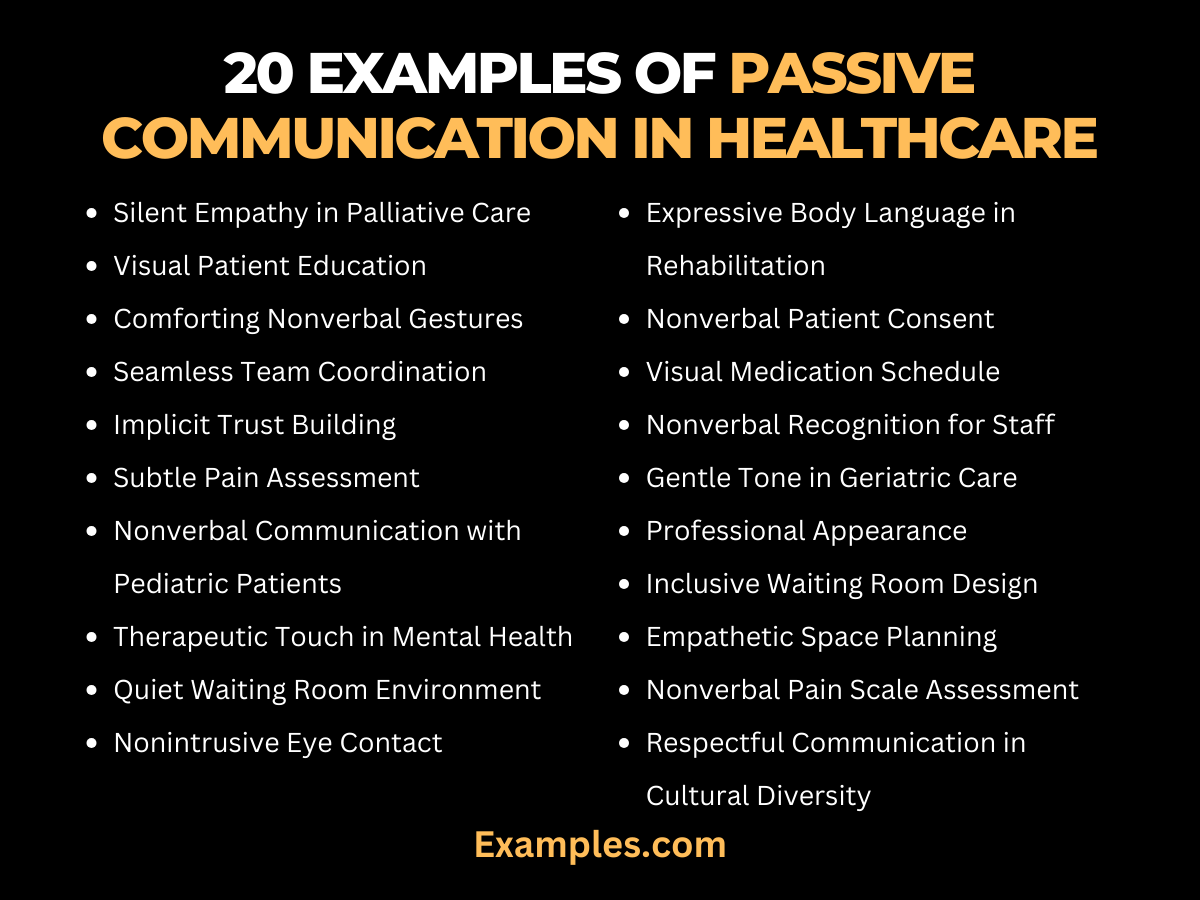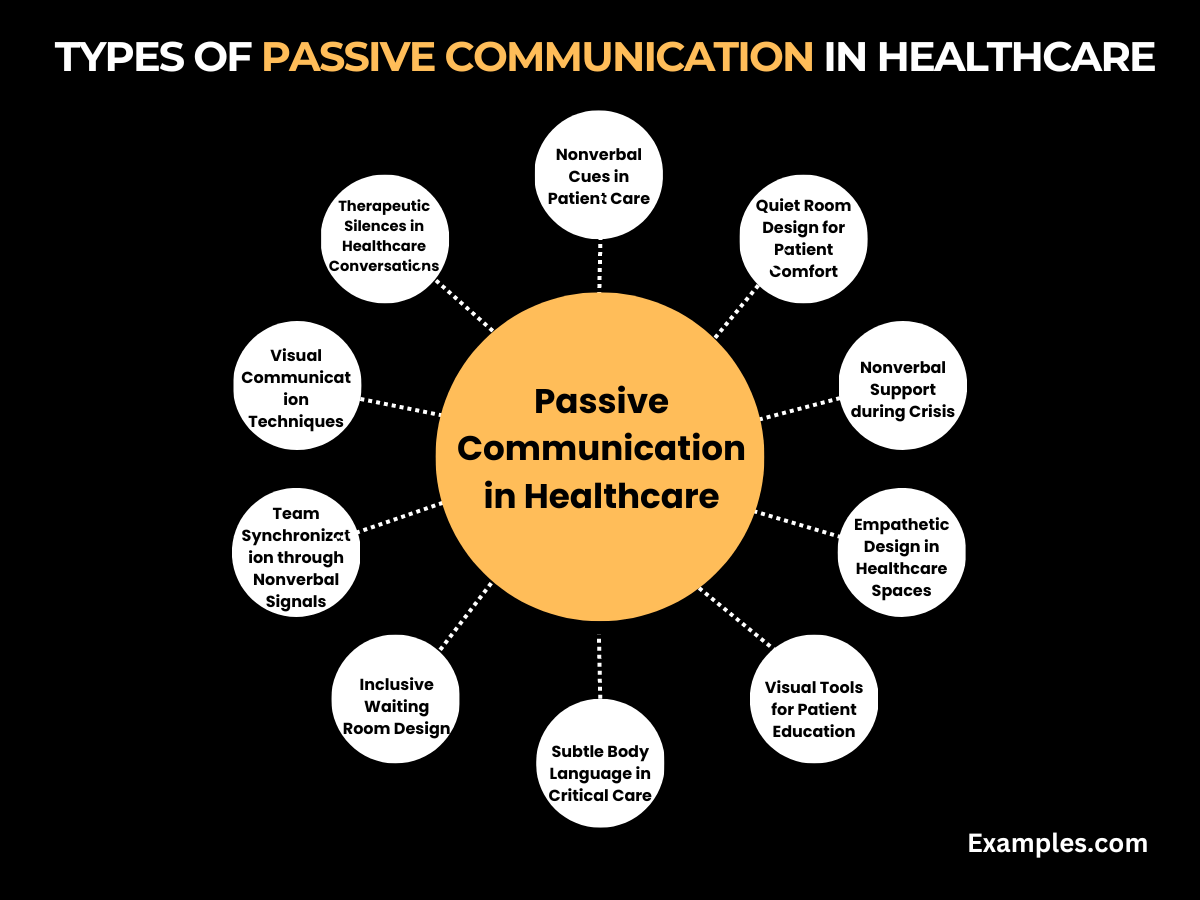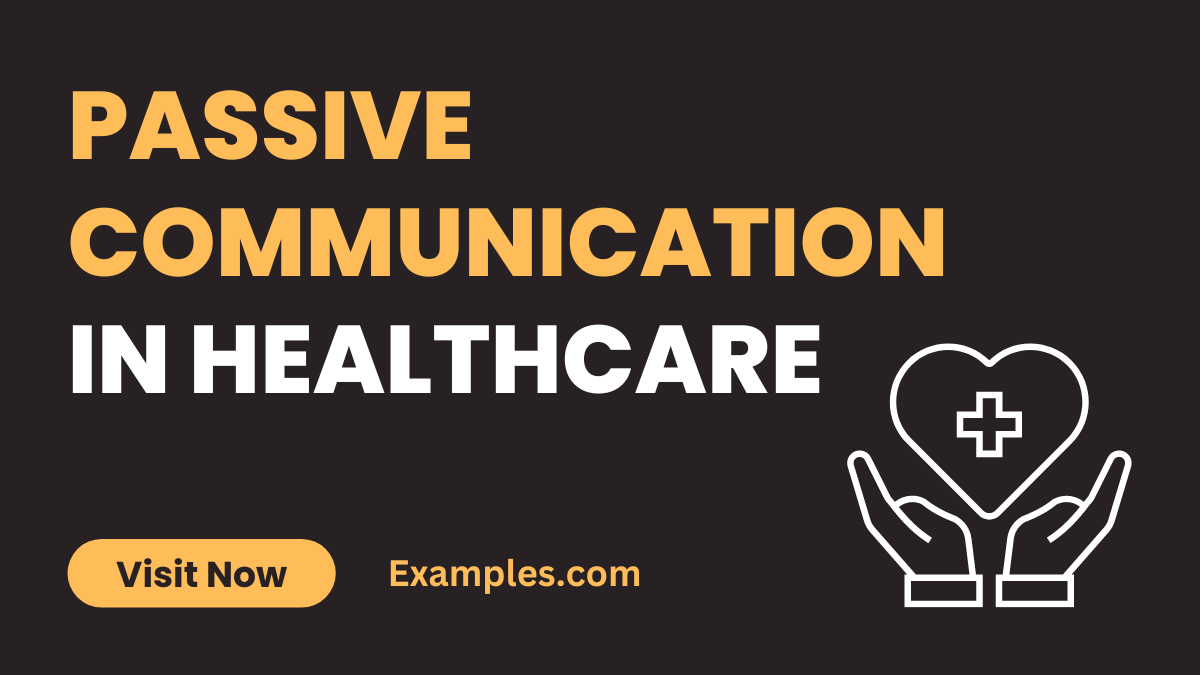19+ Passive Communication in Healthcare Examples
Embark on a comprehensive exploration of Passive Communication in healthcare, where every nonverbal cue plays a vital role in patient well-being. This guide unravels the nuances of effective communication, supported by real-world Communication Examples. From therapeutic gestures to team dynamics, discover how passive communication enhances the healthcare experience, fostering trust, empathy, and a healing environment for both practitioners and patients.
20 Examples of Passive Communication In HealthCare
Unlock the benefits of Passive Communication in Healthcare, transcending spoken words to nurture patient-cantered care. This approach fosters trust, empathy, and smoother medical interactions. Delve into the advantages, from improved patient satisfaction to enhanced team collaboration, creating a healing environment that goes beyond verbal exchanges.

- Silent Empathy in Palliative Care: Caregivers offer comfort through quiet presence, a powerful expression of support in challenging moments.
- Visual Patient Education: Utilizing visuals aids enhances communication, simplifying complex medical information for better patient understanding.
- Comforting Nonverbal Gestures: Soft touches and reassuring nods convey compassion, providing emotional support during distressing situations.
- Seamless Team Coordination: Healthcare teams synchronize nonverbally, ensuring efficient and coordinated care without constant verbal communication.
- Implicit Trust Building: Maintaining consistent body language and demeanour builds trust, reassuring patients and fostering confidence in healthcare providers.
- Subtle Pain Assessment: Observing facial expressions and body language aids in assessing patient discomfort, even when explicit communication is challenging.
- Nonverbal Communication with Paediatric Patients: Paediatric healthcare providers use playful gestures to create rapport, making young patients feel at ease.
- Therapeutic Touch in Mental Health: A gentle touch or hug can provide comfort and support in mental health settings, fostering a sense of security.
- Quiet Waiting Room Environment: Creating a calm atmosphere in waiting areas contributes to patient comfort and minimizes stress during appointments.
- Nonintrusive Eye Contact: Maintaining respectful eye contact without intimidation is crucial in building connections and conveying empathy to patients.
- Expressive Body Language in Rehabilitation: Physical therapists use expressive movements to motivate and guide patients during rehabilitation exercises.
- Nonverbal Patient Consent: Patients often express agreement or disagreement nonverbally, emphasizing the importance of keen observation during healthcare interactions.
- Visual Medication Schedule: Simplifying medication schedules through visual aids helps patients adhere to prescriptions and fosters treatment compliance.
- Nonverbal Recognition for Staff: Colleagues acknowledge and appreciate each other’s efforts through nonverbal cues, creating a positive workplace environment.
- Gentle Tone in Geriatric Care: Softening communication tones ensures comfort for elderly patients, promoting a sense of dignity and respect.
- Professional Appearance: Healthcare practitioners’ attire and demeanour convey competence and instil confidence in patients.
- Inclusive Waiting Room Design: Ensuring accessibility and comfort for all patients in waiting areas enhances the overall healthcare experience.
- Empathetic Space Planning: Designing healthcare spaces with patient comfort in mind contributes to a soothing environment and promotes a sense of security.
- Nonverbal Pain Scale Assessment: Using visual pain scales helps patients communicate pain levels effectively, aiding healthcare providers in appropriate interventions.
- Respectful Communication in Cultural Diversity: Nonverbal cues, such as greetings or gestures of respect, bridge cultural gaps and enhance cross-cultural healthcare communication.
Passive Communication in Healthcare at a Hospital
Enhance patient care through Passive Communication in hospital settings. This approach relies on nonverbal cues and strategic silences, fostering a healing environment. Explore its advantages, from minimizing patient stress to optimizing teamwork for comprehensive healthcare.
- Quiet Room Design: Create calming spaces by incorporating soft colours and comfortable furnishings, reducing patient anxiety.
- Gentle Touch During Exams: Offer reassurance with a gentle touch, helping patients feel more at ease during medical examinations.
- Visual Pain Scale Posters: Utilize visual aids displaying pain scales, aiding patients in expressing discomfort levels more accurately.
- Team Synchronized Rounds: Coordinate healthcare rounds through nonverbal signals, promoting efficiency and patient-centred care.
- Respectful Waiting Room Atmosphere: Maintain a respectful ambiance in waiting areas, ensuring patient comfort and privacy.
- Inclusive Signage Design: Implement clear and inclusive signage for better wayfinding, enhancing the overall patient experience.
- Therapeutic Landscape Planning: Design healing gardens for patients and families, providing a serene outdoor retreat within hospital premises.
- Nonverbal Patient Discharge Instructions: Use visual aids to explain post-discharge instructions, enhancing patient understanding and compliance.
- Expressive Staff Uniforms: Incorporate empathetic design in staff uniforms, promoting a welcoming and caring environment.
- Calm Lighting in Critical Areas: Install soothing lighting in critical care areas to create a calming atmosphere for patients and healthcare providers.
What are the Types of Passive Communication in Healthcare
In the realm of healthcare, mastering passive communication is pivotal for nuanced and empathetic interactions. This comprehensive guide delves into the various types of passive communication, exploring how each type contributes to fostering a healing environment. From nonverbal cues to therapeutic silences, discover the intricacies of these 12 types and how they shape positive patient experiences and facilitate seamless teamwork within healthcare settings.

1. Nonverbal Cues in Patient Care: Explore the art of conveying empathy, comfort, and assurance through subtle gestures, facial expressions, and body language. Learn how healthcare providers use nonverbal cues to establish trust and build rapport with patients.
2. Therapeutic Silences in Healthcare Conversations: Delve into the power of strategic silences in healthcare dialogues. Understand how moments of quiet reflection and pause can enhance communication, allowing patients to express themselves and healthcare providers to listen attentively.
3. Visual Communication Techniques: Uncover the importance of visual communication in healthcare settings. From utilizing visual aids to creating healing environments through thoughtful design, explore how visual elements contribute to effective and compassionate care.
4. Team Synchronization through Nonverbal Signals: Examine the role of nonverbal signals in healthcare teamwork. Understand how synchronized actions and gestures among healthcare teams contribute to seamless coordination and efficient patient care.
5. Inclusive Waiting Room Design: Learn the significance of creating waiting areas that cater to the diverse needs of patients. Explore how inclusive design elements contribute to patient comfort, reduce stress, and enhance the overall healthcare experience.
6. Subtle Body Language in Critical Care: Investigate the nuanced use of body language in critical care situations. Understand how healthcare providers convey empathy, urgency, and reassurance through subtle yet impactful body language cues.
7. Visual Tools for Patient Education: Examine the utilization of visual aids in patient education. Discover how healthcare professionals enhance patient understanding by incorporating visuals into explanations of medical conditions, treatment plans, and post-care instructions.
8. Empathetic Design in Healthcare Spaces: Explore the concept of empathetic design in healthcare spaces. From soothing colours to comfortable furnishings, understand how thoughtful design choices contribute to a healing environment for both patients and healthcare providers.
9. Nonverbal Support during Crisis: Investigate the role of nonverbal support during healthcare crises. Explore how healthcare teams communicate solidarity and support through subtle gestures, fostering a sense of unity in challenging situations.
10. Quiet Room Design for Patient Comfort: Discover the impact of quiet room design on patient comfort. Explore how creating calm and soothing spaces contributes to reducing patient anxiety and promoting a sense of tranquillity in healthcare environments.
11. Subtle Acknowledgment in Healthcare Meetings: Unveil the significance of subtle acknowledgment in healthcare meetings. Learn how nonverbal cues such as nods, smiles, and eye contact contribute to a positive atmosphere and open communication among healthcare professionals.
12. Nonintrusive Patient Feedback Techniques: Explore nonintrusive approaches to gathering patient feedback. Understand how healthcare providers can encourage open communication and continuous improvement without causing discomfort or intrusion into patients’ experiences.
In the realm of healthcare, mastering Passive Communication is paramount. This guide unveils the subtle yet profound impact of nonverbal cues, exemplifying its application through diverse scenarios. From fostering empathy in palliative care to enhancing team coordination, these examples illuminate the transformative power of passive communication. Embrace this holistic guide for a deeper understanding of healthcare’s unspoken language.



